 Scientists have been investigating the specific emotions that separate a nightmare from a bad dream.
Scientists have been investigating the specific emotions that separate a nightmare from a bad dream.
While most of us will remember waking up in the middle of the night after experiencing a particularly terrifying dream, researchers now believe that not all nightmares involve an element of fear. Instead, up to half of the unsettling dreams we experience may revolve around other emotions such as anger or sadness.
The team collected together more than 10,000 dream reports from 572 respondants and analyzed the emotional aspects of both nightmares (that wake the person up) and bad dreams (that generally do not cause the person to awaken.)
What they found was that nightmares tended to feature some form of physical threat such as being chased or falling from a great height, while bad dreams tended to revolve around some sort of psychological threat such as an interpersonal conflict or public embarrassment.
"Death, health concerns and threats are common themes in nightmares, but it would be wrong to think that they characterise all nightmares," said lead author Dr Geneviève Robert. "Sometimes, it is the feeling of a threat or an ominous atmosphere that causes the person to awaken. "
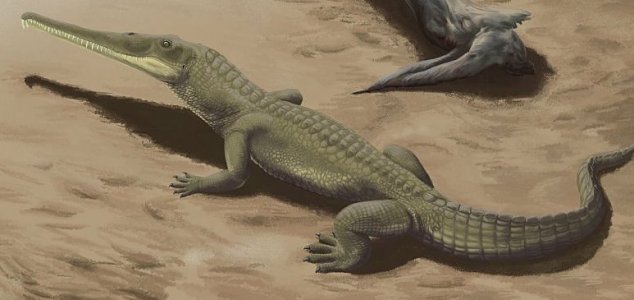 The remains of a prehistoric crocodile-like creature have been discovered in the wilds of west Texas.
The remains of a prehistoric crocodile-like creature have been discovered in the wilds of west Texas.
It is thought that this particular specimen died in a lake over 205 million years ago, sinking to the bottom where its remains ended up being preserved thanks to the dirt and sediment. While only its head survived, palaeontologists were still able to identify it as a new species of phytosaur.
"A phytosaur resembles a crocodile," said Bill Mueller of the Museum of Texas Tech University. "They had basically the same lifestyle as the modern crocodile by living in and around the water, eating fish, and whatever animals came to the margins of the rivers and lakes."
The newly discovered species, which was named Machaeroprosopus lottorum after the family whose ranch the remains were found on, is believed to have grown up to at least 17ft in length.
 Makenzie Wethington had been on a skydiving trip as a treat for her birthday when disaster struck.
Makenzie Wethington had been on a skydiving trip as a treat for her birthday when disaster struck.
The 16-year-old had jumped from the plane over Oklahoma when her parachute became tangled and failed to open properly. Instructors had attempted to offer her assistance over a headset, however she appeared to black out and subsequently plummeted more than 3,000ft to the ground.
As emergency crews rushed to the scene they were amazed to discover that despite some serious injuries, Makenzie was still very much alive. The impact had broken her pelvis, lumbar spine and shoulder blade but thanks to prompt medical intervention she was able to pull through. Doctors are optimistic that she will be able to leave the hospital's intensive care unit soon.
"I don't know the particulars of the accident, as I wasn't there," said trauma surgeon Dr Jeffrey Bender. "But if she truly fell 3,000ft, I have no idea how she survived."
 The ambitious successor to the Hubble will be the most powerful space telescope ever created.
The ambitious successor to the Hubble will be the most powerful space telescope ever created.
Having first been announced back in 1996, the road hasn't been an easy one for the project. Issues with funding almost saw the whole thing cancelled in 2011, but now a critical review milestone has opened the doors to its completion and launch by 2018.
"This is the last major element-level critical design review of the program," said NASA's Richard Lynch. "What that means is all of the designs are complete for the Webb and there are no major designs left to do."
Designed to be the successor to the existing Hubble and Spitzer space telescopes, the James Webb Space Telescope will be optimized to observe the universe in infrared using a much larger mirror and orbiting at a greater distance that its predecessors.
Scientists hope to use the telescope to learn more about the formation of galaxies, planets and stars while peering further in to the depths of space than ever before.
 New research has suggested that the iconic geological formation may be a lot younger than thought.
New research has suggested that the iconic geological formation may be a lot younger than thought.
A popular destination for tourists from all over the world, the Grand Canyon in Arizona is the largest canyon on the planet at 277 miles long, 18 miles wide and over 6,000ft deep. How long ago this spectacle formed however remains a point of contention among scientists.
A 2012 study by Rebecca Flowers of the University of Colorado had suggested that the canyon was up to 70 million years old, placing its formation at a time when dinosaurs still roamed the Earth.
A more recent study however conducted by a different team using a technique known as thermochronology, which identifies when hot rocks from deep underground first reach the surface, has suggested that at least some parts of the canyon could be a lot younger at just 6 to 7 million years old.
"It will take a bit more time to understand fully why their interpretations are so different from ours and why they conclude that the erosion history varied so dramatically within this short reach of the canyon," said Flowers.
 Genetically modified tomatoes with added nutritional value could soon find their way in to supermarkets.
Genetically modified tomatoes with added nutritional value could soon find their way in to supermarkets.
Despite a general lack of consumer interest in any food that has been genetically modified, the new purple-hued tomatoes are being touted as an improvement over traditional red tomatoes due to the addition of anthocyanin, an antioxidant with cancer-fighting properties.
"With these purple tomatoes you can get the same compounds that are present in blueberries and cranberries that give them their health benefits - but you can apply them to foods that people actually eat in significant amounts and are reasonably affordable," said Professor Cathie Martin.
The new tomatoes are being mass-produced in Canada for sale in Britain and elsewhere in the form of fruit juice. The modification process, which involves the transfer of a gene from a snapdragon plant, triggers a process that causes anthocyanin to develop.
Scientists are hoping that the same technique can be used to add nutritional value to other tomato-containing foods such as ketchup and pasta sauce.
 One woman from Kent suffers form an unusual phobia that makes her frightened of newspapers.
One woman from Kent suffers form an unusual phobia that makes her frightened of newspapers.
Diane Freelove has had to endure a paralyzing fear of paper-based publications for more than 25 years, attributing her unusual phobia to uncomfortable childhood experiences involving her father playfully hitting her mother on the head with a rolled up newspaper.
"When I visit a shop, I walk as far away as I can from the newsstand," she says. "I can’t go anywhere near someone who has got one and, if they approach me, I freak out." The 49-year-old has even taken to posting a sign on her door to ask paperboys not to deliver to her address.
Known as Cloephobia, a fear of newspapers is quite rare but not unheard of. It isn't clear exactly how it develops, but like many phobias it can cause the sufferer a great deal of distress in their daily life, even if it might sound rather strange to those who aren't afflicted with it.
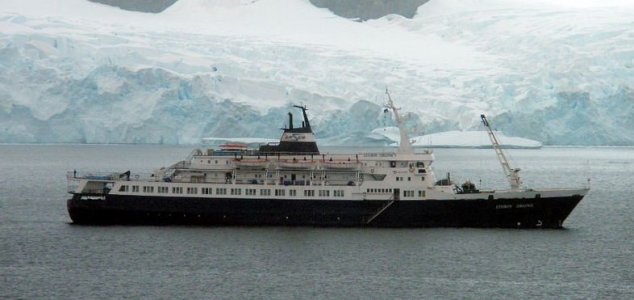 UK authorities are on the look out for an infamous ghost ship that is said to be crawling with rats.
UK authorities are on the look out for an infamous ghost ship that is said to be crawling with rats.
The ill-fated cruise ship Lyubov Orlova might have seemed like any other until, on one fateful day in November 2006, it ran aground in the South Shetlands. Four years later the ship ended up deserted in Newfoundland when the crew walked out over a pay dispute, eventually leading to it being sold for scrap in 2012.
The Orlova's spate of misfortune continued when during an effort to tow it to a scrapyard in the Dominican Republic, the line broke, prompting the decision by authorities to give up on it and set it adrift in the Atlantic.
In the months that followed the ship became something of a legend, a ghost ship, drifting on the tides destined never to reach its destination. Recent reports have suggested that winter storms may have pushed it on a course towards the UK, a possibility that has helped to generate a renewed interest in its story.
To add to the Orlova's intrigue, it has also been suggested that rats stowed away on the vessel, having run out of food, are likely to have resorted to cannibalism to satiate their appetites.
Coastal authorities are still on the look-out for the ship but to date its exact whereabouts remain something of a mystery.
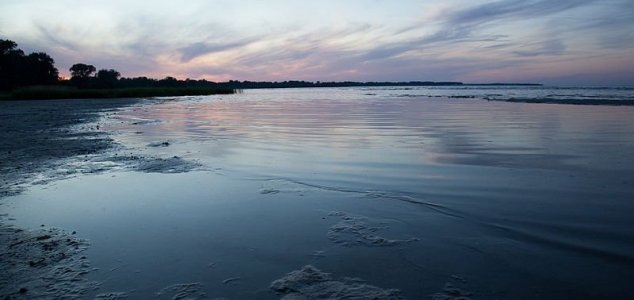 Stone Age artifacts left behind by Swedish nomads have been unearthed on the floor of the Baltic Sea.
Stone Age artifacts left behind by Swedish nomads have been unearthed on the floor of the Baltic Sea.
Divers exploring the bay of Hanö off the coast of Sweden have uncovered a treasure trove of artifacts dating back more than 11,000 years. Made from both stone and bone fragments, the items exhibit impressive levels of preservation thanks to the lack of oxygen and abundance of peat-based sediment on the ocean floor.
"What we have here is maybe one of the oldest settlements from the first more permanent sites in Scania and in Sweden full stop," said Professor Björn Nilsson who lead the project. Among the finds was a harpoon carved from animal bone, flint tools, rope, horns and other items that had once been discarded in to the water.
"Around 11,000 years ago there was a build up in the area, a lagoon or sorts... and all the tree and bone pieces are preserved in it," said Nilsson. "If the settlement was on dry land we would only have the stone-based things, nothing organic."
 For the first time ever, researchers have caught on video the process responsible for memory formation.
For the first time ever, researchers have caught on video the process responsible for memory formation.
The remarkable footage depicts the complex processes of memory formation which involve changes to the molecular structures and synaptic transmissions of the brain.
One of the biggest challenges was making the neurons visible enough to record. Researchers at the Albert Einstein College of Medicine at Yeshiva University managed to solve this by tagging certain molecules with fluorescent markers.
"This observation that neurons selectively activate protein synthesis and then shut it off fits perfectly with how we think memories are made," said lead researcher Robert Singer. "Frequent stimulation of the neuron would make mRNA available in frequent, controlled bursts, causing beta-actin protein to accumulate precisely where it's needed to strengthen the synapse."
 A herd of cows managed to cause a significant gas explosion on a dairy farm in Rasdorf, Germany.
A herd of cows managed to cause a significant gas explosion on a dairy farm in Rasdorf, Germany.
Police investigating the peculiar incident concluded that a stray spark of static electricity had ignited a concentrated area of methane gas produced by the flatulent behavior of around 90 dairy cows. The subsequent explosion blew the roof off the building and injured one of the animals.
Cows are well known for their rather excessive production of methane, with some experts estimating that a single cow can produce anywhere between 100 and 500 liters of the volatile gas each day.
So significant is the problem in fact that some scientists believe methane emissions from cows have been a contributing factor in global warming.
 Researchers have discovered that we possess up to one fifth of our prehistoric cousins' genetic code.
Researchers have discovered that we possess up to one fifth of our prehistoric cousins' genetic code.
In an effort to learn more about the genetic similarities between Neanderthals and modern humans, Benjamin Vernot and Joshua Akey at the University of Washington sequenced the genomes of 600 people and then used a computer to identify gene variants that seemed to be Neanderthal in origin.
Their remarkable results suggested that the combined total amount of Neanderthal DNA present in modern humans was as high as 20%.
"Although Neanderthals are extinct, there's still a lot of genetic information about them floating around, in our own genomes," said Vernot. "It's not necessarily useful in that it will cure cancer, but it helps us to learn about our history."
It is believed that the genetic similarities are the result of encounters between Neanderthals and modern humans up to 65,000 years ago. Despite interbreeding being rare, some of the benefits obtained from the Neanderthal genes would have been sufficient enough to ensure their perseverance in humans all the way up to the present day.
The discovery is particularly helpful to scientists as it means it is possible to study a significant percentage of the Neanderthal genome without having to extract it from ancient fossils.
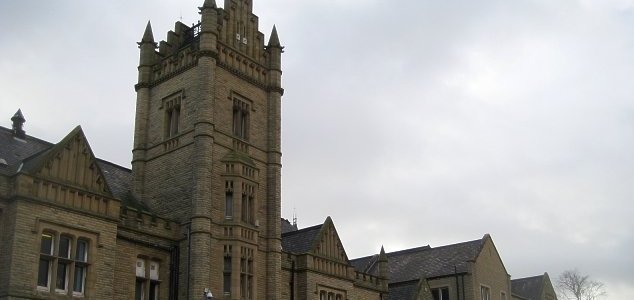 Police officers were called out after a group of 200 youths turned up at an abandoned hospital building.
Police officers were called out after a group of 200 youths turned up at an abandoned hospital building.
Wannabe ghost hunters arrived at Wakefield's Clayton Hispital on Saturday night in their droves after word got out on social media that the building was haunted.
Security guards soon found themselves overwhelmed and were forced to call the police. Four people ended up being arrested but were later released without charge.
"Whether it is haunted or not, it is a dangerous site and members of the public should not enter it for any reason," said Inspector Richard Clare.
The hospital was originally opened back in 1854 but ended up abandoned after it was closed to the public in 2012.
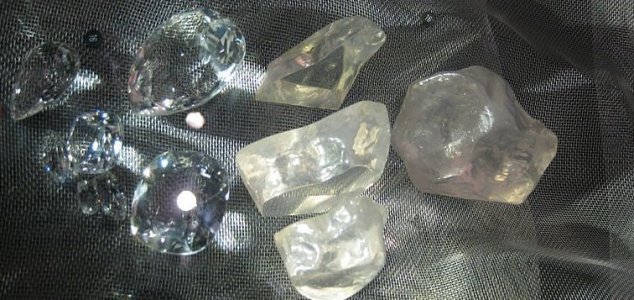 A rare and highly valuable blue diamond has been found in South Africa's famous Cullinan mine.
A rare and highly valuable blue diamond has been found in South Africa's famous Cullinan mine.
The remarkable blue 29.6-carat diamond was extracted by Petra Diamonds and could be worth almost $20 million. Blue diamonds are more rare and valuable than regular diamonds with Cullinan mine being one of the world's best known sources.
"This stone is one of the most exceptional stones recovered at Cullinan during Petra's operation of the mine," said a company spokesman. "The stone is an outstanding vivid blue with extraordinary saturation, tone and clarity, and has the potential to yield a polished stone of great value and importance."
A similar diamond was unearthed back in 2009 and fetched $10 million at auction. The mine was also the place from which the famous 'Star of Africa' blue diamond originated, a 530-carot stone that was presented to King Edward VII and ended up as part of Britain's crown jewels
 Official reports seem to back up the story of a woman in Indiana who claims her children were possessed.
Official reports seem to back up the story of a woman in Indiana who claims her children were possessed.
The strange series of events took place at the home of Latoya Ammons and has attracted the attention of psychologists, medical experts and even the police.
In one report, medical personnel were said to have observed one of the family's young children making peculiar growling noises and being thrown in to the wall by an unseen force. In another, psychologists claimed to have witnessed the family's youngest child "walking up the wall backwards" and talking in strange, deep voices.
"[He] had the weird grin on his face and began to walk backwards while the grandmother was holding his hand and he walked up the wall backwards while holding the grandmother's hand and he never let go," the report stated. "He flipped over and landed on his feet in front of the grandmother and sat down in the chair."
The legitimacy of the case has even been corroborated by Police Captain Charles Austin who, having conducted interviews with Ammons, has stated that he believes the reports to be genuine.
The incidents were believed to have only come to an end after authorities took the decision to remove the children from the house and the hospital chaplain called on Rev Mike Maginot to perform an exorcism on both them and their mother.
"Whenever you would praise God in Latin, no reaction," he said. "But you start condemning the demon, condemning the evil spirit, all of a sudden she [the child] is reacting to that."
 The weather conditions found on a brown dwarf 6.5 light years away have been mapped for the first time.
The weather conditions found on a brown dwarf 6.5 light years away have been mapped for the first time.
Brown dwarfs are an unusual class of star that are larger than gas giant planets such as Jupiter but too small for a nuclear fusion cycle to be sustained. Far cooler than main-sequence stars like our sun, the surface conditions on these enigmatic worlds are nonetheless some of the most hellish seen anywhere in the universe.
Now for the first time scientists have used a technique known as Doppler imaging to produce a map of the weather likely to be experienced by someone visiting Luhman 16B, the closest known brown dwarf star.
The results suggest that the surface of this distant world is subjected to temperatures of up to 1,100C while molten iron rain cascades from gaseous metallic clouds high above.
The grim conditions are so bad in fact that Luhman 16B is now considered to be a contender for the "worst weather in the universe".
 A large wine collection has been found in the ruins of a cellar dating back more than 3700 years.
A large wine collection has been found in the ruins of a cellar dating back more than 3700 years.
The ancient collection was unearthed beneath a ruined palace in the northern Israeli city of Tel Kabri. 40 jars were found in total and each of them had been used to store a sweet, strong wine.
"The wine cellar was located near a hall where banquets took place, a place where the Kabri elite and possibly foreign guests consumed goat meat and wine," said excavation co-director Assaf Yasur-Landau.
While none of the wine itself had survived, archaeologists were able to retrieve and study fragments of the jars to determine what had been in them. Among them were traces of wine-making ingredients such as tartaric and syringic acid as well as honey, cinnamon, mint and juniper berries.
"This wasn't moonshine that someone was brewing in their basement, eyeballing the measurements," said classical studies professor Andrew Koh. "This wine's recipe was strictly followed in each and every jar."
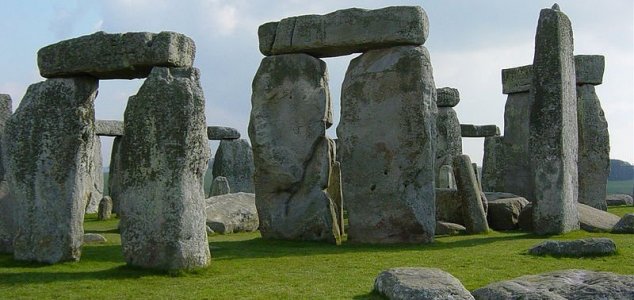 Archaeologists admit that they've been looking for clues in the wrong place for almost 100 years.
Archaeologists admit that they've been looking for clues in the wrong place for almost 100 years.
For the longest time the huge stone slabs that make up the outer ring of the enigmatic Neolithic monument were thought to have originated at Pembrokeshire’s Preseli Hills, but thanks to recent geological studies it has been revealed that the stones instead came from another site located approximately one mile away.
"After this, I don’t expect to be getting Christmas cards from the archaeologists who have excavated at the wrong place all these years," said Richard Bevins of the National Museum of Wales.
The discovery was made by using x-rays to compare the bluestones of Stonehenge with the rocks from both sites to find a positive match.
The exact way in which the stones were originally moved to the site of Stonehenge and set up has remained something of an enigma for thousands of years. Efforts are underway to determine if the stones were manually transported from the hills or if they had been already carried most of the way by a glacier during the last Ice Age.
 Traces of an ancient wooden structure have been found within the sacred Mayadevi temple in Lumbini.
Traces of an ancient wooden structure have been found within the sacred Mayadevi temple in Lumbini.
The structure dates back to around the sixth century BC and is thought to be the oldest Buddhist shrine ever discovered. The find is made even more significant by the fact that the shrine is located at the site at which Gautama Buddha himself was believed to have been born.
"Very little is known about the life of the Buddha, except through textual sources and oral tradition," said archaeologist Robin Coningham. "Now, for the first time, we have an archaeological sequence at Lumbini that shows a building there as early as the sixth century BC."
A team of researchers has been investigating the site for the last three years. The discovery was made after they dug beneath existing brick structures at the temple and used radiocarbon and luminescence dating techniques on a number of collected samples.
"This finding further strengthens the chronology of Buddha's life and was is major news for the millions of Buddhists around the world," said Kosh Prasad Acharya who worked on the excavation.
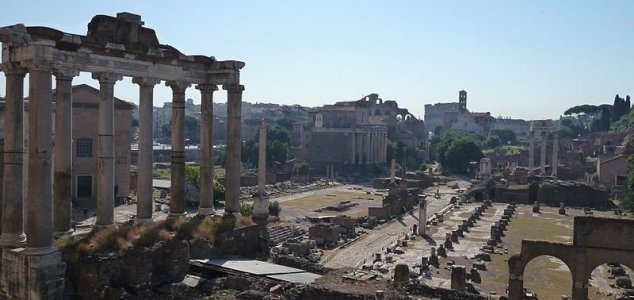 Undearneath the ancient capital lies a complex labyrinth of tunnels and quarries dating back millennia.
Undearneath the ancient capital lies a complex labyrinth of tunnels and quarries dating back millennia.
The tunnels were formed over many hundreds of years thanks mainly to quarrying, weathering and the tendency for the Romans to build new structures over the ruins of old ones. Some of the tunnels have been re-purposed multiple times as catacombs, a sewerage system and even as bomb shelters during World War II.
More recently however the tunnels have started to represent something of a nuisance as modern structures built over the top of them are becoming increasingly vulnerable to subsidence.
Over the last few years there have been several dozen incidents in which buildings have collapsed in to the disused voids beneath the streets.
To combat the problem, a group of geoscientists has undertaken an ambitious new tunnel mapping project to make it possible to more easily identify the points most at risk of collapse. Not only will this help to alleviate the risk to buildings above but it is also providing a unique opportunity to learn more about the vast labyrinth under the city and to find out just how extensive it actually is
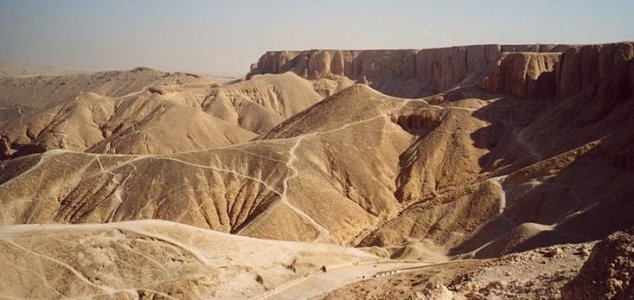 A new radar survey is hoping to find the locations of several tombs that have yet to be discovered.
A new radar survey is hoping to find the locations of several tombs that have yet to be discovered.
Below the shifting sands of Egypt's enigmatic Valley of the Kings lies a host of tombs thousands of years old, yet despite the best efforts of archaeologists there are still many that continue to elude discovery.
This may soon change however thanks to an extensive new survey involving the use of ground-penetrating radar, a technology that works by sending high frequency waves down in to the ground and then picking up any reflections.
Using these signals it is possible to build up a picture of what lies below the sand including, it is hoped, the tombs of several Pharaohs that are known to exist but which have remained undiscovered.
"The consensus is that there are probably several smaller tombs yet to be found. But there is still the possibility of finding a royal tomb," said project field director Afifi Ghonim. "The queens of the late Eighteenth Dynasty are missing, as are some pharaohs of the New Kingdom."
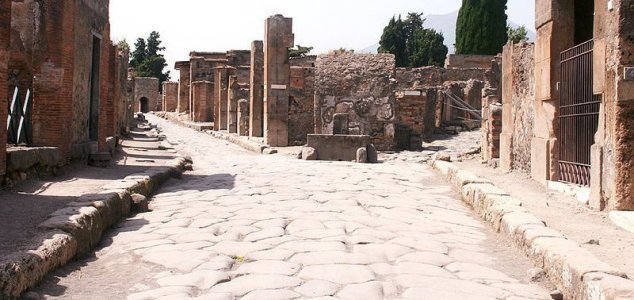 A new study has revealed some of the more unusual diets of those who lived in the doomed Roman city.
A new study has revealed some of the more unusual diets of those who lived in the doomed Roman city.
One of the best known disasters in history, the demise of the ancient Roman city of Pompeii at the hands of a volcanic eruption has provided archaeologists with a treasure trove of clues detailing every facet of how its people lived and died.
One of the myths of ancient Rome that Pompeii has helped to dispel is that of food. While once it was thought that the Roman elite dined on delicacies while the regular townsfolk made do with birdseed and other basic foodstuffs, now it appears that the class divide was nowhere near as extreme.
"The traditional vision of some mass of hapless lemmings - scrounging for whatever they can pinch from the side of a street, or huddled around a bowl of gruel - needs to be replaced by a higher fare and standard of living, at least for the urbanites in Pompeii," said study co-author Steven Ellis.
Instead, the lower classes would have eaten simple but healthy foods while wealthier individuals would have dined on exotic delicacies such as sea urchins and even giraffe.
"This is thought to be the only giraffe bone ever recorded from an archaeological excavation in Roman Italy," said Ellis.
 A recently translated Hebrew text has offered a tantalizing new reference to several ancient treasures.
A recently translated Hebrew text has offered a tantalizing new reference to several ancient treasures.
The text, known as the "Treatise of the Vessels", appears to describe what happened to a number of ancient treasures from King Solomon's temple including the fabled Ark of the Covenant, the biblical chest said to contain the original stone tablets on which the Ten Commandments were inscribed.
Far from providing a precise map to its whereabouts however the text speaks of the Ark rather cryptically, claiming that the exact location "shall not be revealed until the day of the coming of the Messiah son of David."
Having been brought to mainstream attention thanks to movies such as Raiders of the Lost Ark, the Ark of the Covenant remains one of the most highly sought-after and enigmatic artifacts in history. Believed to have been moved from King Solomon's Temple before it was destroyed by the Babylonians in 597 BC, the Ark's final resting place has puzzled historians for centuries.
Over the years several locations have been linked to the Ark including Chartres Cathedral and Rennes-le-Château in France, Mount Nebo near Jerusalem and even a cave in the Dumghe mountains of South Africa, but to date the location of the Ark itself, if indeed it still exists, remains undiscovered.
 A proposal to reduce global warming using tiny reflective particles has been condemned by scientists.
A proposal to reduce global warming using tiny reflective particles has been condemned by scientists.
Climate researchers looking for methods to help curb the effects of global warming have proposed injecting large numbers of tiny reflective particles in to the atmosphere to block out the sun, but scientists looking in to the idea have warned that it could cause more problems than it solves by creating droughts and climate chaos in some of the world's poorest countries.
Another high-profile geo-engineering method, one that involves injecting massive amounts of sulphate particles in to the atmosphere to mimic the cooling effects of a volcanic eruption, has also been criticized on similar grounds.
"We have shown that one of the leading candidates for geo-engineering could cause a new unintended side-effect over a large part of the planet," said study co-author Andrew Charlton-Perez.
"The risks from this kind of geo-engineering are huge. A reduction in tropical rainfall of 30 per cent would, for example, quickly dry out Indonesia so much that even the wettest years after a man-made intervention would be equal to drought conditions now."
While cutting carbon emissions is still the single most effective way to reduce the effects of man-made global warming, it is thought that some geo-engineering methods could still be viable in the future as long as they don't introduce their own unintended environmental consequences.
 A bizarre news report from Iran's Fars News Agency has claimed that America is run by extraterrestrials.
A bizarre news report from Iran's Fars News Agency has claimed that America is run by extraterrestrials.
Fars, which describes itself as "Iran's leading independent news agency", is no stranger to controversy. In a new report published over the weekend, the agency has claimed that NSA documents released by Edward Snowden and analyzed by Russian intelligence services have proved that America's political policies are driven by an "alien/extraterrestrial intelligence agenda".
The report also claims that the recent NSA surveillance controversy is centered around an attempt to cover up these facts and that the US is run by two governments, "the one that was elected, and the other, secret regime, governing in the dark".
The story even goes on to claim that these same aliens assisted the Nazis with the construction of its submarines in the 1930s, then had secret meetings with President Eisenhower in 1954 from which the secret regime was established. It also claims that the extraterrestrial visitors have been working with the US Air Force in Nevada, presumably at the secretive Area 51 base at Groom Lake.
The story has been gaining widespread attention since appearing online, with global news outlets reporting on the bizarre claims and people's reactions to them. Why such a prominent news agency would publish an article like this on a factual basis however, especially when it appears to have been sourced from a controversial conspiracy website, remains somewhat perplexing.
 Police officers were called out after a group of 200 youths turned up at an abandoned hospital building.
Police officers were called out after a group of 200 youths turned up at an abandoned hospital building.
Wannabe ghost hunters arrived at Wakefield's Clayton Hispital on Saturday night in their droves after word got out on social media that the building was haunted.
Security guards soon found themselves overwhelmed and were forced to call the police. Four people ended up being arrested but were later released without charge.
"Whether it is haunted or not, it is a dangerous site and members of the public should not enter it for any reason," said Inspector Richard Clare.
The hospital was originally opened back in 1854 but ended up abandoned after it was closed to the public in 2012.
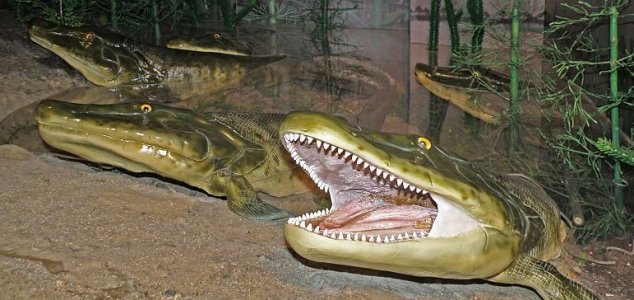 A recently discovered prehistoric fish is believed to exhibit an early precursor to modern arms and legs.
A recently discovered prehistoric fish is believed to exhibit an early precursor to modern arms and legs.
The 375-million-year-old Tiktaalik roseae fossil was discovered by three palaeontologists in the Canadian Arctic and possesses skeletal features, including limb-like fins and large pelvic bones, that are remarkably similar to those found in modern land animals.
This prehistoric crocodile-like fish is likely to have been a transitional species, bridging the gap between animals that lived in the water and animals that lived on the land. Its fins even possess primitive elbow and wrist-type joints.
"That wrist you use to write with, the neck you use to move your head around with, the lungs you’re using to breathe... all derive from parts in the bodies of fish," said Prof Neil Shubin. "Your hands and arms derive from parts of the fins."
It isn't clear at exactly what point Tiktaalik would have been able to emerge from the water and move about on land, but it is thought that it would have been capable of squirming across shallow water, a bit like a mudskipper.
"What the fossil record tells us is how deeply we are connected to life on the rest of the planet. In this case, this tells us how closely we are related to fish," said Prof Shubin.
 Archaeologists have discovered evidence that the residents of an ancient city used eggs to ward off evil.
Archaeologists have discovered evidence that the residents of an ancient city used eggs to ward off evil.
Long before the advent of modern science, people of the ancient world would attribute destructive events such as earthquakes and tsunamis to spirits, demons and other evil forces.
At the site of the ancient city of Sardis where a devastating earthquake once struck, archaeologists have unearthed evidence that its residents once relied on special rituals and charms to ward off evil and prevent subsequent disasters.
Artifacts such as eggshells and coins were found to have been buried as part of these rituals in a discovery that is believed to be one of the few known examples of how natural disasters affected the people of the time on a personal level.
"That's what makes this deposit so interesting," said Elizabeth Raubolt of the University of Missouri. "It's one person's way of coping with the uncertainties and tumultuous events of that period."
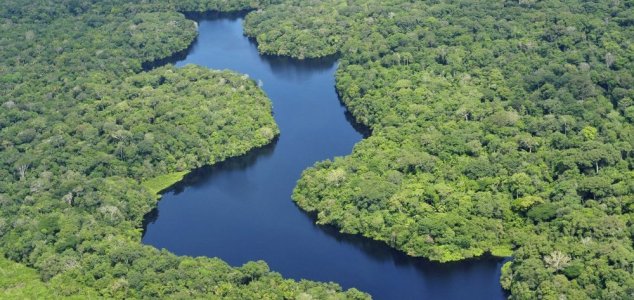 How widespread were pre-Columbian civilizations within the world's largest rainforest ?
How widespread were pre-Columbian civilizations within the world's largest rainforest ?
The Amazon rainforest is one of the most difficult places for archaeologists to study, not only due to its sheer size but also because undertaking an expedition to the region can prove to be both expensive and perilous.
To help make things easier, scientists have come up with a new way to look for signs of pre-Columbian settlements that can be achieved using a computer. The technique involves mapping regions of the rainforest where the soil has been intentionally enriched for agricultural purposes.
By looking for this enriched soil, known as "terra preta", researchers have been able to piece together a map of the rainforest showing the most populated regions over the last 2,500 years. This map can then be used to pinpoint regions with the highest likelihood of finding earthworks hidden beneath the forest canopy.
The results so far suggest that areas with terra preta are most commonly found in the central and Eastern regions while being less commonly found in the west where runoff from the mountains has made the soil more naturally enriched.
 Mystery has long surrounded the strange and protracted death of one of history's greatest leaders.
Mystery has long surrounded the strange and protracted death of one of history's greatest leaders.
Having built one of the ancient world's largest empires, Alexander the Great's death at the age of just 32 has perplexed scholars for centuries. Some believe that members of his inner circle may have plotted to murder him while others believe he died of natural causes.
Having been approached by the team behind a new BBC documentary, toxicologist Dr Leo Sche recently conducted his own investigation in to the mystery in an effort to find out if the Macedonian leader had indeed been poisoned by his enemies.
According to historical records Alexander had taken an agonizing 12 days to die, a fact that ruled out several types of poison such as hemlock and aconite that would have killed him much faster.
Instead, Dr Sche believes that a poisonous plant, Veratrum album, could have been fermented as a wine and given to Alexander during a banquet. Despite the bitter taste, the drink could have been sweetened with other ingredients and given to the leader while he was already intoxicated.
 Scientists remain perplexed by the inexplicable and severe lack of activity being exhibited by the sun.
Scientists remain perplexed by the inexplicable and severe lack of activity being exhibited by the sun.
The sun's activity has dropped to such an extent that there are fears that it could trigger a miniature Ice Age similar to the one that occurred during the 17th century when the sun entered an extremely quiet phase that became known as the Maunder Minimum.
"I've been a solar physicist for 30 years, and I've never seen anything quite like this," said astrophysicist Richard Harrison. The lack of solar activity is particularly surprising because the sun is currently at the peak of its cycle at a time when activity should be at its most intense.
Scientists have warned that it is quite possible that the sun will become increasingly quiet, leading to much colder winters, especially in Europe. The last time this happened both the Baltic Sea and the River Thames froze over.
"It's a very active research topic at the present time, but we do think there is a mechanism in Europe where we should expect more cold winters when solar activity is low," said space environment physicist Professor Mike Lockwood.
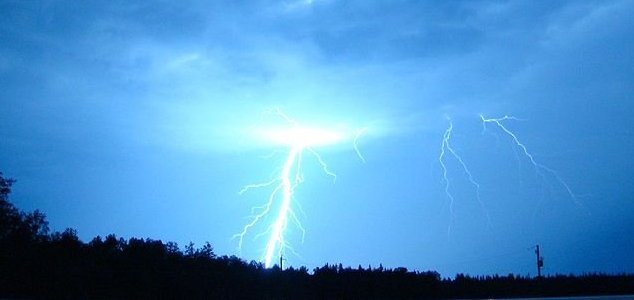 Chinese researchers have managed to observe and film natural ball lightning for the first time.
Chinese researchers have managed to observe and film natural ball lightning for the first time.
Taking the form of a bright sphere of electrical energy, the enigmatic phenomenon was doubted to even exist at all until around the 1960s. Since then scientists have been able to recreate ball lightning in a lab, but nobody had ever been able to satisfactorily record a naturally occurring example.
Now a science team in China believe that they've achieved the impossible by recording footage of ball lightning that formed during a storm in Qinghai. Using a combination of spectrographs and video cameras, the researchers recorded the glowing orb of light as it rose 5 meters above the ground.
"There have been many research programs that routinely video or photograph natural and triggered lightning," said lightning specialist Martin Uman. "But none, as far as I am aware, has stumbled on a ball lightning."
The theory goes that when lightning strikes the ground it can store energy in silicon nanoparticles which then oxidize, releasing their energy in the form of a ball of pure silicon vapor.
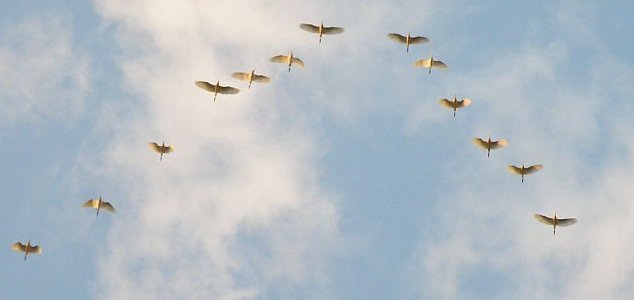 Scientists have been able to determine the advantages of the distinctive formation for the first time.
Scientists have been able to determine the advantages of the distinctive formation for the first time.
Researchers from the Royal Veterinary College investigated the phenomenon by closely observing a flock of birds that had been trained how to migrate by following a human in a microlight aircraft.
Special data loggers were attached to the birds to record information such as speed, position and heading. The results suggested that the classic 'V' formation is optimal for enabling each bird to take advantage of the lift gained from the bird in front of it.
"They're seemingly very aware of where the other birds are in the flock and they put themselves in the best possible position," said Lead researcher Dr Steven Portugal.
The research follows on from a previous study in which pelicans flying in formation were found to have lower heart rates then they did when flying by themselves.
 New research has suggested that running may be more effective than sheltering where you are.
New research has suggested that running may be more effective than sheltering where you are.
The Cold War might be over, but the threat of a nuclear attack on a populated area has never truly disappeared. Traditional advice in the event of a nuclear explosion is to shelter in the nearest protective building, but atmospheric scientist Michael Dillon has determined that there could be a more effective option.
Having realized that not everyone has access to a basement or other appropriate place to use as a fallout shelter, Dillon looked to mathematics to calculate the most effective course of action. What he found was that it is often better to run and try to find better shelter than to stay where you are.
According to his findings, if your current shelter is poor and there is a better option within five minutes travel time then you should go there as soon as possible. If the higher quality shelter is more distant, you should only attempt to reach it if you can do so within 30 minutes of the bomb's detonation.
Dillon believes that if everyone in a major metropolitan area followed this advice in the event of a nuclear bomb detonation it could potentially save up to 100,000 lives.
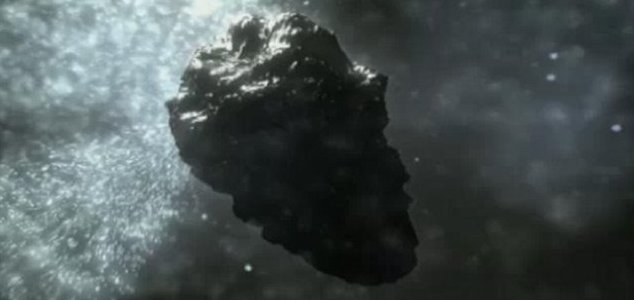 ESA's comet chasing spacecraft has successfully woken up after hibernating for two-and-a-half years.
ESA's comet chasing spacecraft has successfully woken up after hibernating for two-and-a-half years.
Launched by the European Space Agency in 2004, Rosetta has been on-course to a comet known as '67P/Churyumov–Gerasimenko' where it will conduct a number of experiments and land a robot on the surface.
Due to the length of the trip and because the probe relies on solar rather than nuclear power, the spacecraft had been effectively 'put to sleep' for a period of 31 months to help conserve its energy.
Now after a long and agonizing wait scientists have finally received a signal to say that it has successfully awoken from its hibernation as it prepares for the final few months of its approach.
Rosetta's destination is a comet that is thought to be 4.6 billion years old and comes from a time before the Earth even existed and the sun was in its infancy. Scientists hope that by investigating the comet they will be able to find clues to help explain what took place in the earliest days of our solar system such as how the Earth and the other planets originally formed.
 A rare and highly valuable blue diamond has been found in South Africa's famous Cullinan mine.
A rare and highly valuable blue diamond has been found in South Africa's famous Cullinan mine.
The remarkable blue 29.6-carat diamond was extracted by Petra Diamonds and could be worth almost $20 million. Blue diamonds are more rare and valuable than regular diamonds with Cullinan mine being one of the world's best known sources.
"This stone is one of the most exceptional stones recovered at Cullinan during Petra's operation of the mine," said a company spokesman. "The stone is an outstanding vivid blue with extraordinary saturation, tone and clarity, and has the potential to yield a polished stone of great value and importance."
A similar diamond was unearthed back in 2009 and fetched $10 million at auction. The mine was also the place from which the famous 'Star of Africa' blue diamond originated, a 530-carot stone that was presented to King Edward VII and ended up as part of Britain's crown jewels.
 An older person takes longer to remember things because their brain contains so much information.
An older person takes longer to remember things because their brain contains so much information.
It was long believed that as a person gets older they have a more difficult time remembering things due to the cognitive decline of their brain, but now scientists have revealed that it is more likely to be down to the simple fact that the older you are, the more information you have stored in your head.
"The human brain works slower in old age but only because we have stored more information over time," said Dr. Michael Ramscar. "The brains of older people do not get weak. On the contrary, they simply know more."
The effect is being likened to that of a computer with a full hard drive - data takes longer to access than on a computer with more free space.
"Imagine someone who knows two people’s birthdays and can recall them almost perfectly," said Dr Ramscar. "Would you really want to say that person has a better memory than a person who knows the birthdays of 2000 people, but can ‘only’ match the right person to the right birthday nine times out of ten?"
 The world's 85 richest people possess the equivalent wealth of the world's 3.5 billion poorest combined.
The world's 85 richest people possess the equivalent wealth of the world's 3.5 billion poorest combined.
The remarkable divide between the world's richest and poorest people has been highlighted in a new damning report from Oxfam which is attempting to emphasize the extent to which the planet's wealth is controlled by a small 'global elite'.
"It is staggering that in the 21st Century, half of the world's population – that's three and a half billion people – own no more than a tiny elite whose numbers could all fit comfortably on a double-decker bus," said Oxfam executive director Winnie Byanyima.
The growing problem of wealth distribution is one of the issues Oxfam believes needs to be tackled before a proper solution to poverty can be found. "Widening inequality is creating a vicious circle where wealth and power are increasingly concentrated in the hands of a few, leaving the rest of us to fight over crumbs from the top table," said Byanyima.
It is believed that the richest 1% of the world's population control more than $110 trillion, a total equating to 65 times that of the poorest 50%



































